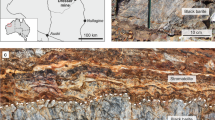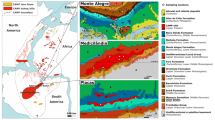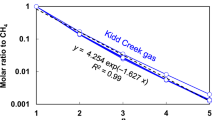Abstract
Arising from: Y. Ueno, K. Yamada, N. Yoshida, S. Maruyama & Y. Isozaki Nature 440, 516–519 (2006); Ueno et al. reply
Ueno et al.1 contend that methane found in fluid inclusions within hydrothermally precipitated quartz in the Dresser Formation of western Australia (which is roughly 3.5 Gyr old) provides evidence for microbial methanogenesis in the early Archaean era. The authors discount alternative origins for this methane, suggesting that the range of values that they record (−56 to −36‰) is attributable to mixing between a primary microbial end-member with a value of less than −56‰ and a mature thermogenic gas enriched in 13C (about −36‰). However, abiotic methane produced experimentally2,3 and in other Precambrian greenstone settings4,5 has 13C-depleted values, as well as relationships that encompass the range measured for the inclusions by Ueno et al. — which suggests that an alternative, abiotic origin for the methane is equally plausible. The conclusions of Ueno et al. about the timing of the onset of microbial methanogenesis might not therefore be justified.
Similar content being viewed by others
Main
The range of isotopic values for abiotic methane shown in Fig. 2c of Ueno et al.1 differs distinctly from those from thermogenic and microbial sources, and does not encompass the methane in their fluid inclusions. However, the range of for abiotic hydrocarbons is larger than that used in their comparison. Abiotic methane end-members in Precambrian Shield rocks extend to much lighter values (−47 to −28‰)4,5. Also, as noted by Ueno et al., experimental studies2 indicate that abiotic synthesis using a Ni–Fe alloy catalyst may produce methane with a range of isotopic compositions ( values of −54 to −19‰ at 200–300 °C) that is similar to the range in the inclusions1. Although those results have not been duplicated2, they have not been disputed either. In fact, hydrothermal abiotic methane synthesis has been confirmed with Ni–Fe alloy6 and other potential mineral catalysts7,8.
The values of measured by Ueno et al. in their inclusions (34–52‰; see their Supplementary Table 2) span a range that is identical to, or even smaller than, those produced in abiotic synthesis experiments (33–66‰)2,3. Furthermore, the experimental range would encompass the larger value the authors infer for primary inclusions ( >52‰). The authors also contend that the lack of C2+ compounds in those inclusions is in agreement with a microbial origin; however, C2+ hydrocarbons were not detected during methane synthesis in abiotic experiments2 either, so such reactions can also produce methane with a low C2+/(C1+C2+) ratio (<<0.01). Therefore, neither an absence of C2+ nor isotopic compositions can distinguish between microbial and abiotic origins for this data set, even when both factors are considered together.
Ueno et al. also discount an abiotic source on the grounds that Fe–Ni alloys and other catalysts for Fischer–Tropsch-type synthesis reactions would not have existed in the surrounding rocks at conditions prevailing during silica precipitation. But abiotic methane could have been synthesized during interaction of migrating hydrothermal fluids with ultramafic rocks elsewhere in the system in the presence of either Ni–Fe alloy or other mineral catalysts, and transported to the site of quartz deposition3,9,10, so the absence of suitable catalysts immediately adjacent to the fluid inclusion-bearing quartz would not preclude an abiotic origin. Indeed, Ueno et al. explain the inferred thermogenic origin of methane in the secondary inclusions using migration from surrounding rocks.
The key criteria used by Ueno et al. to establish a microbial origin for methane in the inclusions from the Dresser Formation are therefore equally consistent with an abiotic origin, and their conclusion about the antiquity of the onset of microbial methanogenesis should be viewed with caution. Biosignatures that are mimicked by abiotic processes need to be analysed closely to evaluate not only signs of life in rocks from the early Earth but also the search for life on other planets.
References
Ueno, Y., Yamada, K., Yoshida, N., Maruyama, S. & Isozaki, Y. Nature 440, 516–519 (2006).
Horita, J. & Berndt, M. E. Science 285, 1055–1057 (1999).
McCollom, T. M. & Seewald, J. S. Earth Planet. Sci. Lett. 243, 74–84 (2006).
Sherwood Lollar, B., Westgate, T. D., Ward, J. A., Slater, G. F. & Lacrampe-Couloume, G. Nature 416, 522–524 (2002).
Sherwood Lollar, B. et al. Chem. Geol. 226, 328–339 (2006).
McCollom, T. M. & Seewald, J. S. Geochim. Cosmochim. Acta 67, 3625–3644 (2003).
McCollom, T. M. & Seewald, J. S. Geochim. Cosmochim. Acta 65, 3769–3778 (2001).
Foustoukos, D. I. & Seyfried, W. E. Jr Science 304, 1002–1005 (2004).
Brasier, M. D. et al. Precambr. Res. 140, 55–102 (2005).
Lindsay, J. F. et al. Precambr. Res. 143, 1–22 (2005).
Author information
Authors and Affiliations
Corresponding author
Rights and permissions
About this article
Cite this article
Lollar, B., McCollom, T. Biosignatures and abiotic constraints on early life. Nature 444, E18 (2006). https://doi.org/10.1038/nature05499
Published:
Issue Date:
DOI: https://doi.org/10.1038/nature05499
This article is cited by
-
Multidomain ribosomal protein trees and the planctobacterial origin of neomura (eukaryotes, archaebacteria)
Protoplasma (2020)
-
Organo-mineral associations in chert of the 3.5 Ga Mount Ada Basalt raise questions about the origin of organic matter in Paleoarchean hydrothermally influenced sediments
Scientific Reports (2019)
-
Challenges in evidencing the earliest traces of life
Nature (2019)
-
FTIR microspectroscopy of carbonaceous matter in ~ 3.5 Ga seafloor hydrothermal deposits in the North Pole area, Western Australia
Progress in Earth and Planetary Science (2018)
-
The Last Universal Common Ancestor: emergence, constitution and genetic legacy of an elusive forerunner
Biology Direct (2008)
Comments
By submitting a comment you agree to abide by our Terms and Community Guidelines. If you find something abusive or that does not comply with our terms or guidelines please flag it as inappropriate.



